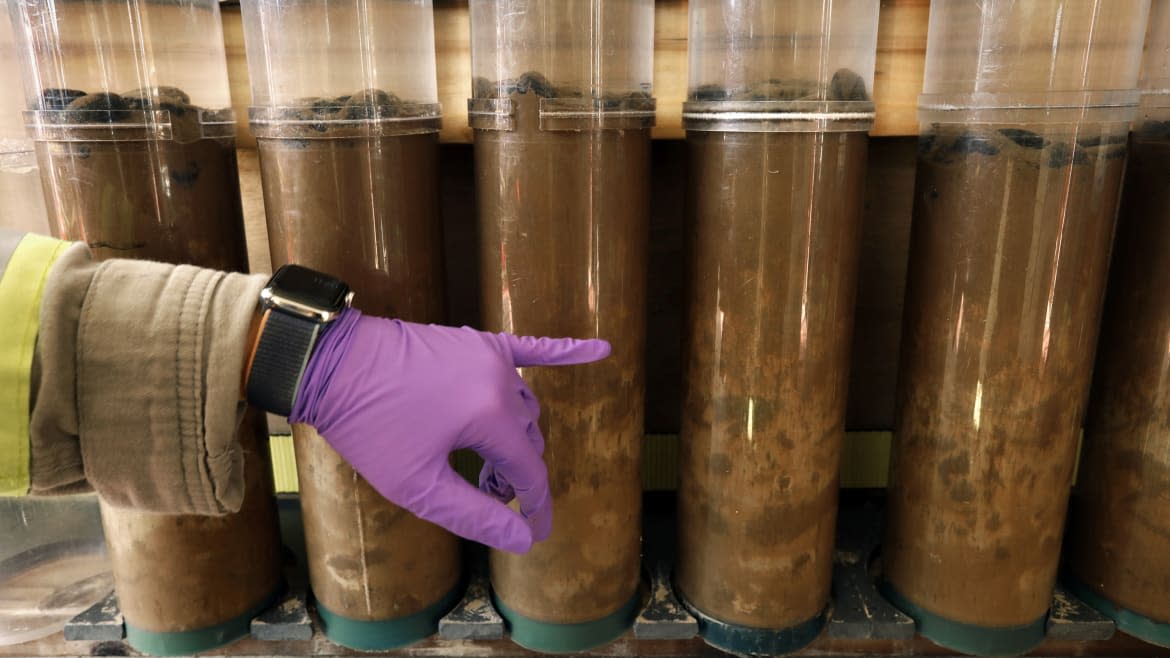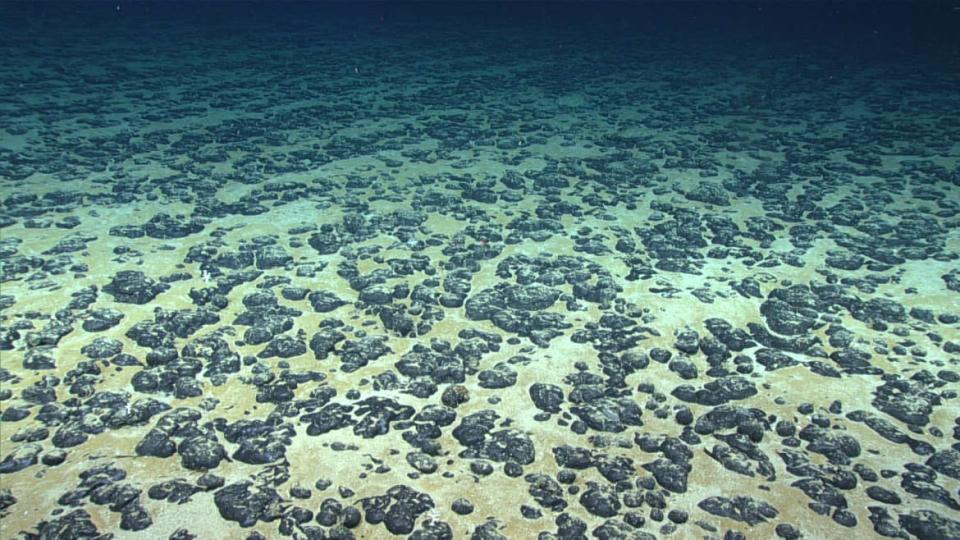Deep Sea Mining May Uplift Clean Energy—and Curse Our Oceans

Miles beneath our ocean’s surface, a seemingly alien environment has lain undisturbed for hundreds of millions of years, in perpetual darkness except for scattered flickers from bioluminescent creatures. Thousands of species of animals including fish, sea cucumbers, brittle stars, corals, anemones, and sponges evolved to live their lives in the crushing deep sea pressures among smaller creatures like worms and bacteria. The backdrop evolved alongside its inhabitants, slowly locking away carbon dioxide and building up clumps of minerals and metals.
It is those metals that have made the seabed a target for industrial mining activities that many marine scientists fear will permanently destroy this pristine environment.
The looming threat is a bit ironic, since one of the incentives to dive deep for these metals is to aid our shift toward clean energy to help heal our planet from climate change. But we need more supplies to fuel this “green” revolution. Batteries for electric vehicles alone require vast amounts of cobalt, manganese, and nickel. Many eyes have turned to the deep-sea floor as a possible source for these valuable metals.
Over the course of millions of years, dissolved minerals and metals precipitated into little potato-sized clumps that stick partway out of the seabed. Called polymetallic nodules, these rich sources of cobalt, nickel, manganese, and copper are found by the trillions in areas such as the Clarion-Clipperton Zone (CCZ)—a region of ocean floor about the size of the continental U.S., located between Mexico and Hawaii.
How to Weaponize Our Dying Oceans Against Climate Change
The billions of tons of nodules in the CCZ alone could be worth trillions of dollars. But many scientists fear the real price we’ll pay for excavating these metals will be irreparably damaging our oceans.
Though we rely on the ocean for food, tourism, biotechnology, coastal protection, pharmaceuticals, and so much more, it’s still relatively unexplored—especially the seabed. According to NOAA, “More than eighty percent of our ocean is unmapped, unobserved, and unexplored.” For most of human history, it’s simply been too expensive and too difficult to venture down to these depths.
That’s changed in recent years. Now that we’re developing machines to harvest deep sea nodules, several large companies with deep pockets are planning to invest billions of dollars in future deep sea mining knowing they can expect billions more in profit.
While we’ve come up with ways to extract resources from the deep sea, scientists are still working to understand the targeted environments. If we mined the seabed today, we could unwittingly destroy the home of thousands of unknown species. We could push these creatures to extinction without ever knowing their role in the global ecosystem or the possible fallout their absence might cause. The environmental organization Greenpeace has also reported that disturbing deep-sea sediment could release significant amounts of naturally sequestered carbon, though some scientists anticipate only a small impact.

Hundreds of polymetallic nodules littered across the seafloor.
Regardless of the effect on sequestered carbon, the clouds of disturbed sediment released during mining may be disruptive to both deep-sea dwellers and creatures that inhabit shallower depths. A July 2020 paper highlights some of the potential fallout, from threats to biodiversity to interference with fisheries, and a July 2021 paper suggests that these plumes may spread widely in the water. Further studies are needed to evaluate long-term ecological effects.
There are even more unknowns. How much will the noise and light associated with mining activities disturb sea life? How will we monitor such remote activities to keep an eye on the environmental impact? Who will regulate deep sea mining, and how, and based on what standards? Deep sea mining is currently regulated by the International Seabed Authority (ISA), but a growing number of ocean scientists and activists are casting doubt on the ISA’s ability to enact and uphold suitable standards.
“There is justifiable concern that deep sea mining may do more harm than good,” Craig Smith, a professor of oceanography at the University of Hawaii, told The Daily Beast. “Humans have a long history of abusing the ocean through things like pollution and overfishing. We need to be wary that deep sea mining doesn’t go the same way, wreaking havoc on biodiversity and disrupting the marine ecosystem.”
Seeing Earth as a Whole
However, Smith added that this is the first time there’s been such a push to be environmentally responsible before allowing the potentially harmful activities to begin. So far, the ISA has awarded around 30 exploration contracts to various companies for deep sea mining. Each requires the contractor to conduct multi-year scientific studies to help characterize the targeted region, the creatures that live there, and the potential impacts of mining activities. In other words, the contracts are actually creating the opportunity to study the deep sea like never before—especially in the CCZ.
In addition, the ISA has set aside a greater area in the CCZ for conservation than for potential exploitation, though some studies indicate this may not guarantee enough protection for the region.
Still, after all that science, the next step is presumably deep sea mining. Few people will disagree that mining operations are environmentally destructive. The question, in this case, is whether deep sea mining will have a more drastic impact than increasing current mining efforts.
After all, mining land for the same metals found in polymetallic nodules comes with a heavy cost, too. The Guardian reported in February that drinking water near one of the biggest nickel mines in Indonesia is contaminated with a carcinogen. Copper and cobalt mines in the Democratic Republic of Congo have also been in the spotlight in recent years due to human rights issues. The local population isn’t protected from mining-related toxins, which have been linked to increased rates of birth defects. Researchers have also documented child labor in Congolese cobalt mines.
A purported benefit of deep sea mining is that no humans, and relatively few animals, live there. However, ocean scientists counter that a major difference is that deep-sea fauna is highly diverse, largely unknown, and likely endemic—meaning these species may not be found anywhere else. Threatening their environment means putting them at risk of total extinction.
The Enticing Energy Fix That Could Make Us Carbon-Neutral
But what about on land? A 2011 study found that 91 percent of ocean species likely remain unknown to science. Already 86 percent of land species have yet to be identified. In areas such as southeast Sulawesi, an Indonesian island, nickel mining requires wiping out immense areas of rainforests which threatens endemic primate species. This is a known threat to biodiversity.
Collecting nodules will have a more permanent impact on the environment than currently legal practices such as deep sea trawling. This practice involves weighing down a net and dragging it across the bottom of the ocean to catch fish, scarring the seabed and often catching enormous quantities of throwaway animals they weren’t targeting. Since nodules stick out of the sediment, companies could essentially vacuum them up without having to scrape at the seafloor. However, the hundreds of species that live on nodules will not recover for millions of years, until the nodules regrow.
Some proponents of deep sea mining also contend that land-based mining is a potential threat to national security. Part of the reason costs for some metals are on the rise is that they come from conflict-heavy or geopolitically difficult areas. About 20 percent of the world’s high-grade nickel, used in batteries for electric vehicles as well as stainless steel, comes from Russia. The supply chain can be as long as 50,000 miles and usually includes the metals going to China for processing prior to reaching their final destination.
Some crucial metals simply aren’t found in large enough quantities in the U.S. to just get them locally. Even when they are, we’re often prohibited from tapping into them by environmental issues. There’s even a global high-grade nickel shortage that threatens the scalability of electric vehicle production. Deep sea mining for nodules could open up access to enormous stores of valuable metals while cutting the supply chain down to well under 5,000 miles.
The Best Path Forward?
A paper published in April highlights many of the gaps in our understanding that limit our ability to assess the impact of mining the seabed. Scientists are currently working to fill those gaps, and no one is legally permitted to mine the seabed in international waters until the ISA approves their environmental impact assessments and mitigation strategies.
Some companies are on track to advance to the next stage later this year: small-scale test mining. But many are calling for a moratorium on commercial deep sea mining, even though it hasn’t begun yet. The Deep Sea Conservation Coalition, an environmental alliance that aims to preserve biodiversity, has stated that its support of a moratorium hinges on its goal to protect life and ecosystems in the deep sea. But what about the rest of the planet?
The final decision may be to move forward with deep sea mining, to conduct land-based mining more responsibly (which would still face the problem of growing shortages of high-grade metals), or to develop alternatives that require smaller amounts of the targeted metals. But nearly every party with a stake in this issue seems to acknowledge that mining will proceed in some version.
“If deep sea mining moves forward, it will be very important to proceed slowly until we better understand the impacts it has on ocean ecosystems,” Smith told The Daily Beast. “Once we destroy vast areas of deep seabed habitat, there will be no going back. These ecosystems will take millions of years to recover.”
Get the Daily Beast's biggest scoops and scandals delivered right to your inbox. Sign up now.
Stay informed and gain unlimited access to the Daily Beast's unmatched reporting. Subscribe now.

